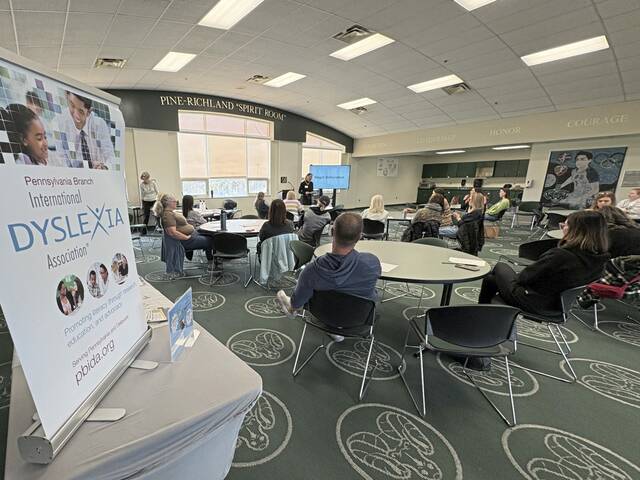https://triblive.com/news/education-classroom/dyslexia-simulation-reveals-challenges-20-of-population-faces/
Dyslexia simulation reveals challenges 20% of population faces

Hailey Levin has known for years that her daughter is dyslexic.
But experiencing for the first time what it might be like for her, she said, was almost heartbreaking.
Levin was among about two dozen people, largely parents like herself, who participated in a dyslexia simulation event the Pennsylvania branch of the International Dyslexia Association held Wednesday, Oct. 22, at Pine-Richland High School’s stadium. October is Dyslexia Awareness Month.
It was intended to help them appreciate what it’s like to be a student in a classroom with dyslexia — a learning impairment that causes problems with reading, writing and spelling, but not a reflection of a person’s intelligence.
“It’s neurological,” said Christine Seppi of Pittsburgh, a former president of the association’s Pennsylvania branch. “That means it’s in the brain.”
Dyslexia affects 20% of the population and represents 80% to 90% of all those with learning disabilities, making it the most common of all neurocognitive disorders, according to The Yale Center for Dyslexia and Creativity. It can’t be outgrown or cured.
Levin said her daughter, now in seventh grade, was diagnosed in third grade when they lived in Houston before moving to Pine. But she had seen her struggle in school since first grade.
She and the others experienced having dyslexia through several sessions touching on reading, listening, writing, math and spelling. A reading session saw them trying to read from a book where letters were replaced with symbols. They then had to take notes listening to their teacher when there were multiple teachers speaking at the same time.
Sessions involving math had them do arithmetic where a number was replaced with a letter representing a number, such as “A” for one and “B” for two. Another had them taking dictation with their nondominant hand while also writing three letters differently — “@” for “a,” “$” for “s” and “E” for “e.”
A spelling test involved 10 words with long “e” sounds.
The participants struggled to complete the tasks, saying they found them frustrating and unfair. Seppi said they were experiencing in a short time what a child with dyslexia feels over an entire school day.
“I had an idea what dyslexia was, but I don’t think I understood without the simulation,” Levin said, then thinking of her daughter. “It made me feel like I really understand what she goes through.”
Erin Riley of Pine said she came to gain a better understanding of people different than herself.
“I was really eye-opening to what it feels like to be in school and to struggle,” she said.
Melanie Lam of Pine also called the experience eye-opening, as well as personal and emotional.
“It really helped me to better experience dyslexia than I ever could by just reading about it or talking to someone about it,” she said.
Maura Paczan, Pine-Richland’s director of student services, reviewed what her district does to identify students with dyslexia and the supports it provides.
But that is going to vary from district to district, as there is no statewide requirement for schools to screen children for dyslexia, said Denise Morelli of Mt. Pleasant, Washington County, a member of the Pennsylvania chapter and a retired educator who is herself dyslexic.
While many districts are beginning to screen students, Morelli said her organization and others believe it should be universally required and done as early as preschool and kindergarten, before the detriments of struggling begin to mount and take their toll.
“It would not define that a child is dyslexic. We’re locating children that may have reading difficulty and then looking further into what those difficulties are,” Morelli said. “We can identify difficulties and when we are able to identify those difficulties and provide interventions early, we’re able to see progress in students.”
Dyslexia was not something students were diagnosed with when Morelli, now 69, was a child, and there weren’t the services there are now. All she knew was that everything came easy to her twin brother while she had to work extra hard, primarily in reading. In fact, it wasn’t until after she started her master’s program — and she would go on to earn a doctorate — that the pieces came together.
“It was somewhat of a relief that, OK, there’s a reason my brain does not function like others when it comes to reading and those types of things,” she said.
As those at the simulation were told, dyslexia can affect a child’s self-confidence. They’re anxious about being called on in class and may think they are stupid. They’ll come up with their own strategies for disguising or hiding it, which at some point may fail. Some will act up, favoring being seen as a class clown instead of thought of as stupid.
Seppi said her youngest son is dyslexic, something they didn’t know until after fourth grade, when he got the help he needed. He went on to earn a master’s degree at Carnegie Mellon University.
“He’s only one of thousands and thousands of kids who need the help he got,” she said.
Dyslexics, Morelli said, will give up on themselves, unless someone believes in them — as others had believed in her.
“All along there were people that believed in me and said, ‘I think you can do this,’ when I didn’t think I could myself. If they think I can do it, maybe I can,” she said. “No one works harder than these children. We just need to continue to believe in them.”
Copyright ©2025— Trib Total Media, LLC (TribLIVE.com)
